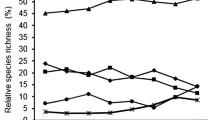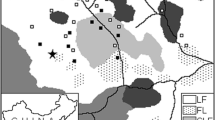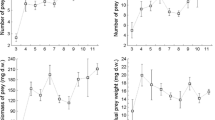Summary
We consider the dietary relationships of the numerically dominant breeding bird species in four North American grassland/shrubsteppe habitats, sampled over 2–3 consecutive years. Overall, the diets of these species contained primarily insects: orthopterans comprised 29% of the diet biomass, coleopterans 24%, and lepidopteran larvae 23%, while seeds contributed 15% of the average diet. These diets varied substantially, however, and we evaluated several aspects of this variation. Intersexual differences in diets within a species were few, despite the occurrence of significant sexual size dimorphism in several species. For many species, however, there were substantial shifts in dietary composition between years at a given location; overall, the average between-year similarity of species' dietary composition was 70%. Different species exhibited rather different diet patterns. Horned Larks were relatively omnivorous, had broad diet composition niches, and varied considerably in diets between different locations. Meadowlarks were also broad-niched and geographically variable in their diets, but were the most highly carnivorous of the species we considered. Dietary niche breadths of Grasshopper Sparrows were intermediate, but diet composition was rather stable, both between years and between locations. Chestnut-collared Longspurs exhibited narrow diet niches, but substantial annual variation: each year this species apparently exploited a different but limited set of prey types rather heavily. Larger avian predators generally consumed a broader array of functional groups of prey, but did not differ in the taxonomic variety of their diets from small birds. Variation in diet composition between individuals within local populations was considerable; in most species, an individual contained on the average 30–40% of the prey taxa represented in entire population smaples.
Patterns of dietary overlap among species were quite inconsistent from year to year at most locations, although at the shrubsteppe site overlap among all species present was consistently quite high. Relatively few cooccurring species pairs exhibited low diet overlap. The degree of diet niche overlap was unrelated to body size differences of the birds, despite as much as six-fold differences in weight among some coexisting species. Relationships of the bird species on another dimension of the trophic niche, prey size, also differed substantially between sites and years. The ranking of co-occurring species by the mean sizes of the prey they consumed generally did not parallel their rankings by body sizes, and in some cases the smallest and the largest species present ate prey of similar sizes. At the shrubsteppe site, all the breeding species exhibited quite similar frequency distributions of prey sizes in their diets.
As species number and diversity increased in the breeding avifaunas, diet niche breadths generally decreased, species packing by prey size decreased, and diet composition niche overlap remained relatively unchanged. These trends are in at least partial agreement with predictions of diffuse competition theory, but the patterns were derived from broad inter-site comparisons of overall site averages, and the relationships generally did not hold within local assemblages of species. In general, our attempts to match values of dietary niche features with site characteristics failed to demonstrate close agreement with the predictions of prevailing ecological theory based upon assumptions of resource limitation and competition. Instead, our findings seem generally most consistent with the suggestion that food is not normally limiting to bird populations in these systems, and individuals and populations are exploiting the food resources in an opportunistic fashion, which leads to considerable individual, between-year, and between-location variation in diet compositions and interspecific overlaps.
Our attempts to discern clear relationships that accord with theoretical expectations in these avian assemblages are thwarted by our lack of detailed information on the resource base and by the lack of clear tests that will separate alternative hypotheses of community organization and structuring. We suggest that these complications may compromise the findings of many community studies.
Similar content being viewed by others
References
Baker, M.C.: Shorebird food habits in the Eastern Canadian Arctic. Condor 79, 56–62 (1977)
Baker, M.C., Baker, A.E.M.: Niche relationships among six species of shorebirds on their wintering and breeding ranges. Ecol. Monogr. 43, 193–212 (1973)
Beaver, D.L., Baldwin, P.H.: Ecological overlap and the problem of competition and sympatry in the Western and Hammond's flycatchers. Condor 77, 1–13 (1975)
Brown, J.H.: Geographical ecology of desert rodents. In: Ecology and evolution of communities (M.L. Cody, J.M. Diamond, eds.), pp. 315–341. Cambridge, Mass.: Belknap Press 1975
Brown, J.H., Liebermann, G.A.: Resource utilization and coexistence of seed-eating desert rodents in sand dune habitats. Ecology 54, 788–797 (1973)
Cody, M.L.: Competition and the structure of bird communities. Monogr. Popul. Biol. No. 7. Princeton, N.J.: Princeton Univ. Press 1974
Cohen, J.E.: Food webs and niche space. Monogr. Popul. Biol. No. 11. Princeton, N.J.: Princeton Univ. Press 1978
Colwell, R.K., Futuyma, D.J.: On the measurement of niche breadth and overlap. Ecology 52, 567–576 (1971)
Connell, J.H.: Diversity in tropical rain forests and coral reefs. Science 199, 1302–1310 (1978)
Custer, T.W., Pitelka, F.A.: Correction factors for digestion rates for prey taken by Snow Buntings (Plectrophenax nivalis). Condor 77, 210–212 (1975)
Custer, T.W., Pitelka, F.A.: Seasonal trends in summer diet of the Lapland Longspur near Barrow, Alaska. Condor 80, 295–301 (1978)
Davidson, D.W.: Foraging ecology and community organization in desert seed-eating ants. Ecology 58, 725–737 (1977)
Diamond, J.M.: Niche shifts and the rediscovery of interspecific competition. Am. Sci. 66, 322–331 (1978)
Ellis, J.E., Wiens, J.A., Rodell, C.F., Anway, J.C.: A conceptual model of diet selection as an ecosystem process. J. Theor. Biol. 60, 93–108 (1976)
Emlen, J.M.: Ecology: an evolutionary approach. Reading, Mass.: Addison-Wesley 1973
Hansen, S.R.: Resource utilization and coexistence of three species of Pogonomyrmex ants in an Upper Sonoran grassland community. Oecologia 35, 109–117 (1978)
Herrera, C.M., Hiraldo, F.: Food-niche and trophic relationships among European owls. Ornis Scand. 7, 29–41 (1976)
Hespenheide, H.A.: Prey characteristics and predator niche width. In: Ecology and evolution of communities (M.L. Cody, J.M. Diamond, eds.), pp. 158–180. Cambridge, Mass.: Belknap Press 1975
Hill, M.O.: Diversity and evenness: a unifying notation and its consequences. Ecology 54, 427–432 (1973)
Jarman, P.J.: The social organisation of antelope in relation to their ecology. Behaviour 48, 215–266 (1974)
Lack, D.: Population studies of birds. Oxford: Clarendon Press 1966
Lack, D.: Ecological isolation in birds. Cambridge, Mass.: Harvard Univ. Press 1972
Leigh, E.G., Jr.: Population fluctuations, community stability, and environmental variability. In: Ecology and evolution of communities (M.L. Cody, J.M. Diamond, eds.), pp. 51–73. Cambridge, Mass.: Belknap Press 1975
MacArthur, R.H.: Species packing and what competition minimizes. Proc. Natl. Acad. Sci. USA 64, 1369–1371 (1969)
MacArthur, R.H.: Geographical ecology. New York: Harper and Row 1972
MacArthur, R.H., Levins, R.: Competition, habitat selection, and character displacement in a patchy environment. Proc. Natl. Acad. Sci. USA 51, 1207–1210 (1964)
MacArthur, R.H., Pianka, E.R.: On optimal use of a patchy environment. Am. Natur. 100, 603–609 (1966)
Marti, C.D.: Feeding ecology of four sympatric owls. Condor 76, 45–61 (1974)
May, R.M.: On the theory of niche overlap. Theor. Popul. Biol. 5, 297–332 (1974)
May, R.M.: Some notes on estimating the competition matrix, α. Ecology 56, 737–741 (1975)
May, R.M.: Models for two interacting populations. In: Theoretical ecology. Principles and applications (R.M. May, ed.), pp. 49–70. Philadelphia: W.B. Saunders 1976
May, R.M., MacArthur, R.H.: Niche overlap as a function of environmental variability. Proc. Natl. Acad. Sci. USA 69, 1109–1113 (1972)
M'Closkey, R.T.: Niche separation and assembly in four species of sonoran desert rodents. Am. Natur. 112, 683–694 (1978)
McNaughton, S.J., Wolf, L.L.: Dominance and the niche in ecological systems. Science 167, 131–139 (1970)
Menge, B.A., Sutherland, J.P.: Species diversity gradients: synthesis of the roles of predation, competition, and temporal heterogeneity. Am. Natur. 110, 351–369 (1976)
Pianka, E.R.: Sympatry of lizards (Ctenotus) in Western Australia. Ecology 50, 1012–1030 (1969)
Pianka, E.R.: Niche overlap and diffuse competition. Proc. Natl. Acad. Sci. USA 71, 2141–2145 (1974)
Pianka, E.R.: Competition and niche theory. In: Theoretical ecology. Principles and applications (R.M. May, ed.), pp. 114–141. Philadelphia: W.B. Saunders 1976
Pianka, E.R.: Reptilian species diversity. In: Biology of the reptilia, vol. 7 (C. Gans, D.W. Tinkle, eds.), pp. 1–34. New York: Academic Press 1977
Rogers, L.E., Buschbom, R.L., Watson, C.R.: Length-weight relationships of shrubsteppe invertebrates. Ann. Ent. Soc. Amer. 70, 51–53 (1977)
Rotenberry, J.T.: Components of avian diversity along a multifactorial climatic gradient. Ecology 59, 693–699 (1978)
Rotenberry, J.T.: Dietary relationships among shrubsteppe passerine birds: competition or opportunism in a variable environment? Ecol. Monogr. (in press)
Rotenberry, J.T., Wiens, J.A.: Nongame bird communities in northwestern rangelands. USDA Forest Serv. Gen. Tech. Rept. PNW-64, 32–46 (1978)
Schoener, T.W.: Theory of feeding strategies. Ann. Rev. Ecol. Syst. 2, 369–404 (1971)
Schoener, T.W.: Resource partitioning in ecological communities. Science 185, 27–39 (1974)
Schoener, T.W.: Competition and the niche. In: Biology of the reptilia, vol. 7 (C. Gans, D.W. Tinkle, eds.), pp. 35–136. New York: Academic Press 1977
Selander, R.K.: Sexual dimorphism and differential niche utilization in birds. Condor 68, 113–151 (1966)
Simpson, E.H.: Measurement of diversity. Nature 163, 688 (1949)
Sims, P.L., Singh, J.S., Lauenroth, W.K.: The structure and function of ten western North American grasslands. I. Abiotic and vegetational characteristics. J. Ecol. 66, 251–285 (1978)
Sokal, R.R., Rohlf, F.J.: Biometry. San Francisco: W.H. Freeman and Co. 1969
Stander, J.M.: Diversity and similarity of benthic fauna off Oregon. Unpubl. M.S. thesis, Corvallis: Oregon State University
Watson, A. (ed.): Animal populations in relation to their food resources. Oxford: Blackwell Scientific Pub. 1970
Werner, E.E., Hall, D.J.: Competition and habitat shift in two sunfishes (Centrarchidae). Ecology 58, 869–876 (1977)
Wiens, J.A.: Pattern and process in grassland bird communities. Ecol. Monogr. 43, 237–270 (1973)
Wiens, J.A.: Climatic instability and the “ecological saturation” of bird communities in North American grasslands. Condor 76, 385–400 (1974)
Wiens, J.A.: On competition and variable environments. Am. Sci. 65, 590–597 (1977 a)
Wiens, J.A.: Model estimation of energy flow in North American grassland bird communities. Oecologia 31, 135–151 (1977 b)
Wiens, J.A., Dyer, M.I.: Rangeland avifaunas: their composition, energetics, and role in the ecosystem. USDA Forest Serv. Gen. Tech. Rept. WO-1, 146–182 (1975)
Wiens, J.A., Rotenberry, J.T.: Bird community structure in cold shrub deserts: competition or chaos? Proc. 17th Intern. Ornithol. Congr. (in press)
Wiens, J.A., Ward, J.F., Rotenberry, J.T.: Dietary composition and relationships among breeding bird populations on US/IBP Grassland Biome sites. U.S. IBP Grassland Biome Tech. Rep. No. 265, 1–92 (1974)
Yeaton, R.I.: An ecological analysis of chaparral and pine forest bird communities on Santa Cruz Island and mainland California. Ecology 55, 959–973 (1974)
Zimmerman, J.L.: The territory and its density dependent effect in Spiza americana. Auk 88, 591–612 (1971)
Author information
Authors and Affiliations
Rights and permissions
About this article
Cite this article
Wiens, J.A., Rotenberry, J.T. Diet niche relationships among North American grassland and shrubsteppe birds. Oecologia 42, 253–292 (1979). https://doi.org/10.1007/BF00346594
Received:
Issue Date:
DOI: https://doi.org/10.1007/BF00346594




